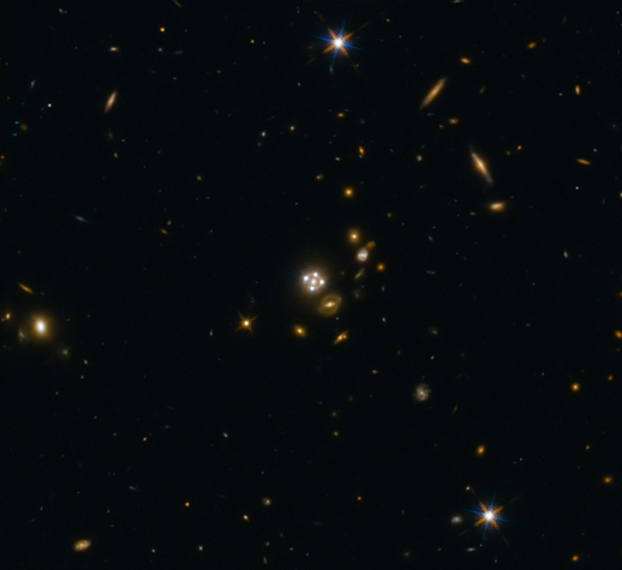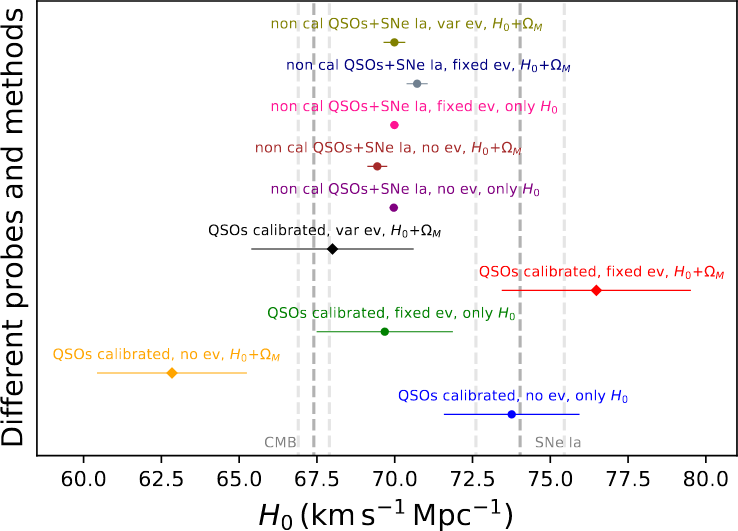Astronomy Object of the Month: 2023, January
< previous Archive
Crisis in Cosmology: statistics on the rescue
An international team of scientists from Italy, Poland, and Japan has released a groundbreaking article with a solution to one of the biggest challenges of modern observational cosmology. A new statistical method was applied in order to remove the impact of selection biases on cosmological computations while avoiding circular reasoning. The article has been accepted for publication in The Astrophysical Journal Supplement Series.

Figure 1. In the center of the image, there is a quasar lensed by the galaxy. Four evenly distributed dots are images of the same quasar, as an effect of gravitational lensing of beams of light by the galaxy in front of the quasar. Credit: ESA/Hubble, NASA, Suyu et al. (Lensed quasar and its surroundings | ESA/Hubble (esahubble.org))
Modern cosmology has many open questions: how to solve the discrepancy between the measurements of the Hubble constant? What is the curvature of space-time? What is the nature of dark energy? And many, many more. Astronomers are trying to shed new light on these issues by observing the Universe farther and farther away from the Earth. This is driven by the fact that predictions from different cosmological models have minor differences at a low distance. Still, those differences begin to be significant for objects very far away from us.
In order to probe the high-distance Universe, scientists have to use the most luminous objects that ever existed, quasars and Gamma-Ray Bursts. Quasars are powered by the accretion of gas onto the supermassive black holes, residing in the centers of galaxies. Gamma-Ray Bursts originate when a massive star explodes, or when two neutron stars, or a neutron star and a black hole merge. Since the discovery of these objects, many correlations between their physical quantities have been studied. These correlations allow us to determine the distance of these objects from us. This is crucial for cosmological analyses, since we have the theoretical formula for the distance in a given cosmological model, which includes the speed of the expansion of the given point in the Universe. This given speed can be measured spectroscopically, thus we can compute the theoretical distance of a particular object for a given cosmological model. The comparison of the theoretical distance and the observed one allows us to test how well the given cosmological model fits the data.
But looking at high distances has shortcomings: the farther away we look, the less luminous events we see. This phenomenon is called the Malmquist bias effect. This can induce an artificial correlation between the observed parameters, so how do we know if the given correlation is a physical feature of the objects, or just induced by a selection effect? This can be tested via a method proposed by Efron & Petrosian (1992) and already successfully developed for the Risaliti-Lusso relation of the quasars by Dainotti et al. 2022 (article by the same authors as the mainly discussed work). This technique eliminates the correlation between the studied parameters and the observational spectroscopic parameter determining the distance (the redshift).
This method creates yet another problem. Many correlations involve luminosity, and in order to calculate the luminosity, one needs to fix the parameters of the cosmological model. Then, with those fixed values, one determines the correction for the selection bias effect. Consequently, this correction has been applied within the assumed cosmological model. Thus, if we would like to use these corrected values to test some cosmological model, our results will be again biased by the model assumed a priori. This represents the so-called circular reasoning problem and cannot be applied to scientific approaches.
The new article completely overcomes this issue, by creating a new, more general treatment than the one of Efron & Petrosian (1992). This treatment was first discussed by Dainotti et al. (2022), and later has been fully implemented by Lenart & Bargiacchi et. al (2023). Lenart & Bargiacchi et. al (2023) have proposed a method which treats the correction for selection bias as a function of the cosmological parameters, allowing to obtain a general formula of correction, valid for any value of cosmological parameters, which can be applied without assuming any values a priori.
The application of this method to the so-called Risaliti-Lusso correlation linking two luminosities for quasars allowed for the first time in the literature to obtain a 2 sigma value of ΩM, the parameter denoting the current amount of matter in the Universe. Moreover, the authors applied the following analysis to study the impact of high-distance measurements on the so-called H0 tension (the incompatibility of the two measurements of the Hubble constant: the one involving supernovae type Ia and the one obtained from the Microwave Cosmic Radiation). Surprisingly, quasars seem to prefer the value of the Hubble constant in between the values obtained for supernovae type Ia and Microwave Cosmic Radiation. This suggests that this discrepancy might be driven by some still unknown physics, and not by the statistical effects. Although in order to confirm such a conclusion, the new correction has yet to be applied also to other samples like supernovae type Ia. The overall results enhance a further significant improvement in cosmological measurements and an extension of our knowledge about the Universe at high distances.

Figure 2. On the left, uncorrected correlation between luminosity measured in an X-ray band and visible light, while on the right, the same correlation, but corrected for evolution and selection bias with the described method. On the left, we can see a clear evolution of the correlation with redshift, while on the right no such evolution can be spotted. Credit: Original publication.

Figure 3. The values of H0 obtained for different samples and methods. Grey vertical lines
represent the values of H0 computed with the Cosmic Microwave Background radiation data (on the left) and supernovae Ia data (on the right).
After the addition of quasars data to the supernovae Ia, one can spot that results fall perfectly between the two before mentioned values. Credit:
Original publication.
Original publication: Aleksander Łukasz Lenart, Giada Bargiacchi, Maria Giovanna Dainotti, Shigehiro Nagataki, Salvatore Capozziello, A bias-free cosmological analysis with quasars alleviating H0 tension, arXiv:2211.10785 [astro-ph.CO] (2022).
The publication under discussion was made possible, amongst others, thanks to financial support from the Astronomical Observatory of Jagiellonian University in Cracow and the Program Council for Mathematical and Natural Sciences Studies at Jagiellonian University. We also acknowledge the National Astronomical Observatory of Japan and RIKEN for their support in realising the work and partially funding the publication.
|
Aleksander Lenart Astronomical Observatory Jagiellonian University Aleksander.Lenart [@] student.uj.edu.pl |


